Orbea send the Gain M20i into the race and, with some additional power from Ebikemotion, want to snag the win. Can an E-road bike be the best road bike of the 2021 season? And how does it perform in comparison to the other two ebikes and 12 purely muscle-powered contenders? Find out all the answers here.
For an overview of the test fleet head to the group test: The best road bike of 2021 – 15 models in review
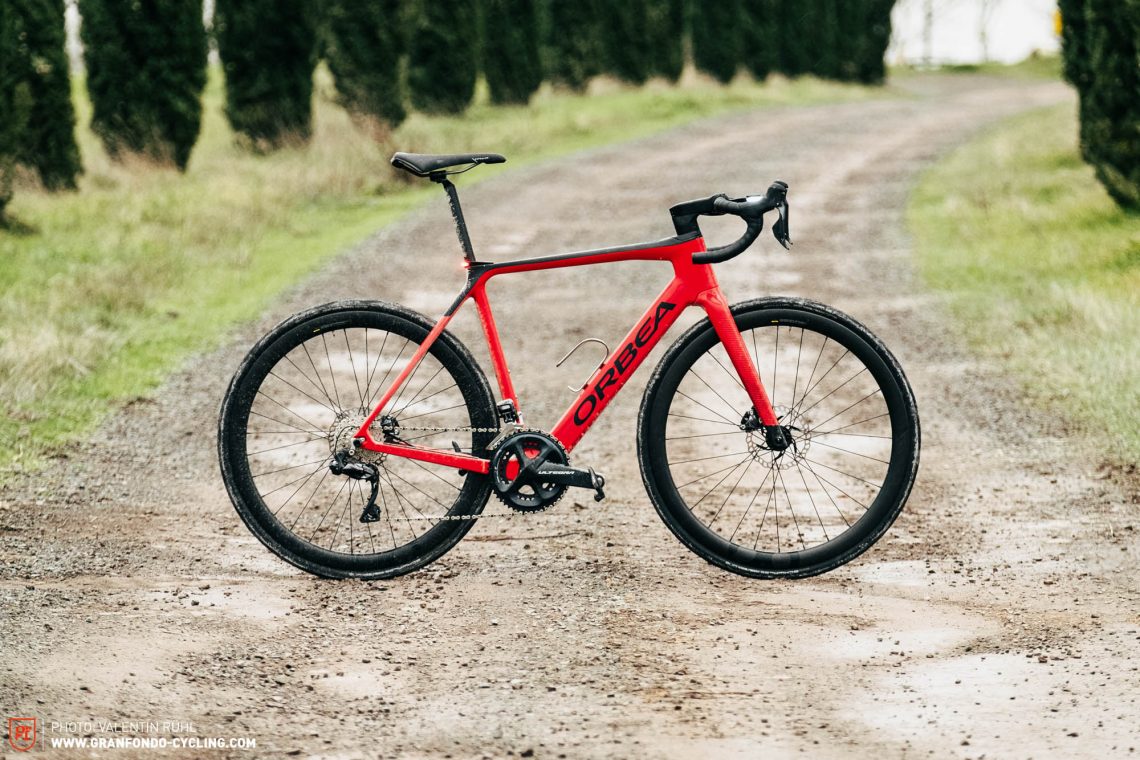
Does riding road bikes always have to be about muscle power or should the experience take the fore? For Orbea, the latter counts more and the Spanish brand is convinced that we’ll be more able to take in those experiences the more relaxed we are. That’s why with the Gain M20i they rely on an E-road bike for this group test. At the heart of the bike is the MAHLE Ebikemotion X35+ system, whose components are so inconspicuously integrated into the frame that the Orbea isn’t immediately recognisable as an ebike. Only the 250 W, 40 Nm hub motor at the rear reveals there’s something else going on. In addition, there’s a 252 Wh battery hidden in the down tube, the charging port by the bottom bracket and the PAS sensor integrated into the freewheel. This is used by the system’s control software to match the speed of the motor to that of the cassette, implicitly detecting the rider’s effort and produce the required motor power in response. However, because the Ebikemotion X35+ system can’t measure the rider’s power directly to modulate the motor’s output the system has some weaknesses as it can only detect how quickly the pedals are turning, not how much force is being put into them. This means the motor, just like its counterpart in the SCOTT Addict eRIDE Premium, sometimes delivers full power in situations where it’s not required or even disturbing, for example when manoeuvring or through tight corners.

The power supply for the motor is routed externally under the left chainstay, making the plugged connection easy to access and the rear wheel easy to remove. The cable is hidden in the groove in the chainstay – neatly solved!
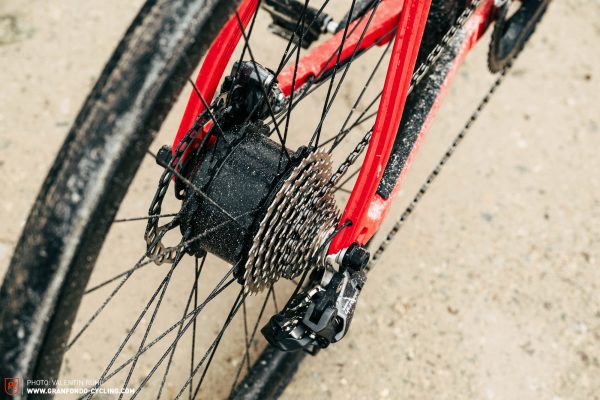
The rear wheel of the Orbea contains the 250 W, 40 Nm hub motor of the MAHLE Ebikemotion X35+ drive system. The motor weighs 2.1 kg and is the only element that identifies this as an ebike.

This button is called iWoc ONE and brings the bike to life. It turns the motor on and off as well as letting you select between assistance modes.
Orbea Gain M20i 2021
€ 6,299
Specifications
Motor MAHLE Ebikemotion X35+ 40 Nm
Battery Ebikemotion 36V/6.9A ANT+ 252 Wh
Seatpost OC2 Carbon 27,2 mm
Brakes Shimano ULTEGRA BR-R8070 160/160 mm
Drivetrain Shimano ULTEGRA Di2 R8050 2 x 12
Chainring 50/34
Stem OC2 Road 100 mm
Handlebar OC2 Road 420 mm
Wheelset OC2 Carbon 42 12 x 100/Nabenmotor mm Thru-Axle
Tires Schwalbe One TLE 30-622 (700x30C) 31
Cranks Shimano ULTEGRA FC-R8000 170 mm
Cassette Shimano ULTEGRA CS-R8000 11–32
Technical Data
Size XS S M L XL
Weight 12.22 kg
Specific Features
clean battery integration and integrated look
generous tire clearances up to 700 x 40C
smart light integration (powered by ebike battery)
optional 208 Wh Range Extender
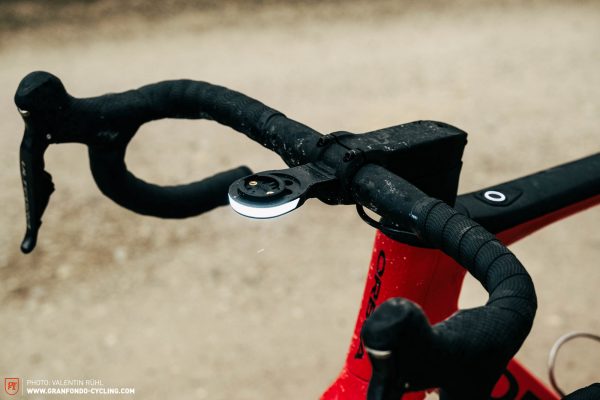
The bike has daylight running lights that are unobtrusively integrated and connected directly to the battery, meaning they don’t have to be charged. They add a little extra safety on every ride. For the front, an optional headlight is available to let you find your way home at night too.

The charging port of the Orbea Gain M20i is in the lower corner of the main triangle, directly above the bottom bracket. It’s not particularly cleanly integrated like with the SCOTT and this position is exposed to dirt and potential dribble from your bottles.
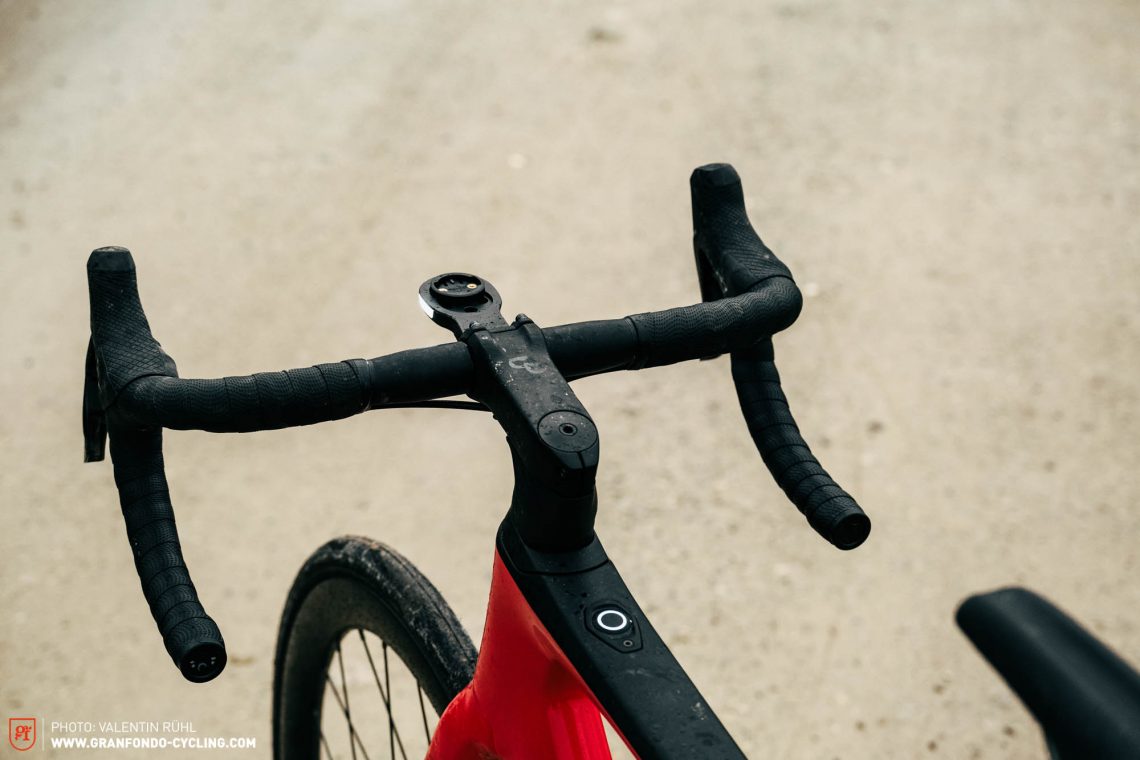
Orbea’s own 100 mm OC2 stem and 420 mm wide OC2 bars make clean integration of the cockpit cabling possible. However, the delicate-looking bars don’t really match the overall look of the bike.
On the other hand, the Ebikemotion app is interesting, allowing you to tune the desired motor assistance in each of the three assistance modes. In addition, it also helps you with navigating on rides, displaying ride data and, when using a heart rate monitor, setting heart rate zones against which the motor support is matched. With Shimano ULTEGRA Di2 for the shifting and brakes, the Gain M20i plays in a lower league than the ebike competition from SCOTT and Trek. If you want to be at the same level, you’ll have to reach for the top-end Gain M10i. The drivetrain with 50/34 t chainrings and 11–32 t cassette is sufficient for steep climbs in combination with the extra power. For long and hilly rides or alpine rides, you should make sure to have the 208 Wh range extender with you. The build is rounded out with OC2 Carbon 42 wheels which are shod in 31 mm wide Schwalbe ONE TLE tires with tubes inside – one of just two setups in the test still relying on tubes. The tires leave lots of space in the 40 mm maximum clearances of the Gain. For the cockpit, the bar and stem from the OC2 road series are used. The bar in particular is very stiff and responsible for the imbalanced comfort of the bike, which swallows vibration and bumps significantly better at the rear.
| Size | XS | S | M | L | XL |
|---|---|---|---|---|---|
| Seat tube | 455 mm | 485 mm | 515 mm | 545 mm | 575 mm |
| Top tube | 507 mm | 530 mm | 547 mm | 571 mm | 589 mm |
| Head tube | 95 mm | 120 mm | 146 mm | 172 mm | 196 mm |
| Head angle | 71.0° | 71.5° | 72.0° | 72.0° | 72.5° |
| Seat angle | 75.0° | 74.5° | 74.5° | 74.0° | 74.0° |
| Chainstays | 420 mm | 420 mm | 420 mm | 420 mm | 420 mm |
| BB Drop | 76 mm | 76 mm | 74 mm | 74 mm | 74 mm |
| Wheelbase | 986 mm | 1,001 mm | 1,022 mm | 1,041 mm | 1,049 mm |
| Reach | 366 mm | 377 mm | 388 mm | 399 mm | 410 mm |
| Stack | 525 mm | 550 mm | 575 mm | 600 mm | 625 mm |

Jersey Specialized Trail-Series Thermal Jersey LS | Pants Rapha Men’s Cargo Bib Shorts
Shoes Suplest EDGE+ Road Pro | Socks Specialized Hydrogen Vent Tall Road Socks
The Orbea Gain M20i in review
Despite the unequal distribution in comfort between the stiffer front and more comfortable rear, the Orbea Gain M20i is more comfortable overall than the SCOTT Addict eRIDE Premium. It also invites you to head out for longer rides than its Swiss competitor thanks to the more compact position, though it can’t match the comfort of the Trek Domane+. Big hits are transmitted to the rider too directly for that, though wider tires could lend some additional help. The handling also matches the image of a relaxed long-distance steed but ends up less aggressive and precise than the SCOTT. In particular, the rear straggles a little due to the heavy hub motor, resulting in more sluggish handling, though it always remains predictable. Together with the bike’s high stability, that results in a distinctly secure-feeling ride which beginners will be able to manage well. It’s just the unexpected activation of the motor while turning that can sometimes lead to hairy moments.
Attach the range extender and ride as far as the battery will take you! The Orbea Gain M20i invites you on extended cruises.

In terms of speed, the Gain M20i invites you to spend most of your time cruising and also maintains speed nicely above 25 km/h on the flats. However, it can’t match the sporty response and pace of the SCOTT. The SCOTT pulls ahead most obviously when the motor support fades away due to its better aerodynamics. On the hills, like the SCOTT, the Orbea is happiest between 5 and 9% grades. On slopes below that, you’ll usually be above the assistance threshold and above, the power of the hub motor reaches its limits. The modulation of the motor at the 25 km/h limit is unobtrusive and natural. The Orbea Gain M20i costs € 6,299, can be customised with the MyO program without any surcharge and weighs 12.22 kg in size M. That puts it between the Trek Domane+ LT 9 and the SCOTT Addict eRIDE Premium in terms of weight and a good 3.7 kg above the average weight of the test field.
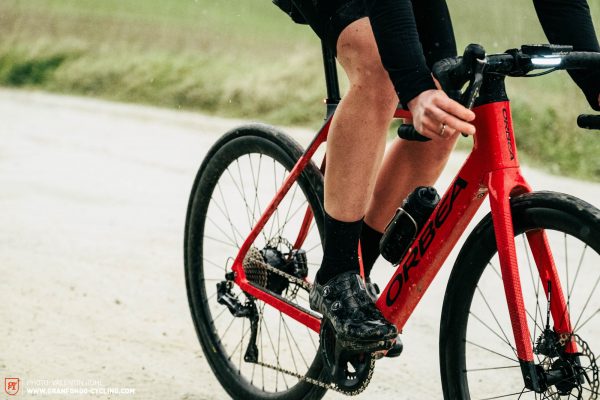

Tuning tips: bars with more compliance to balance out the comfort between the front and rear | tires with more volume and damping to increase overall comfort
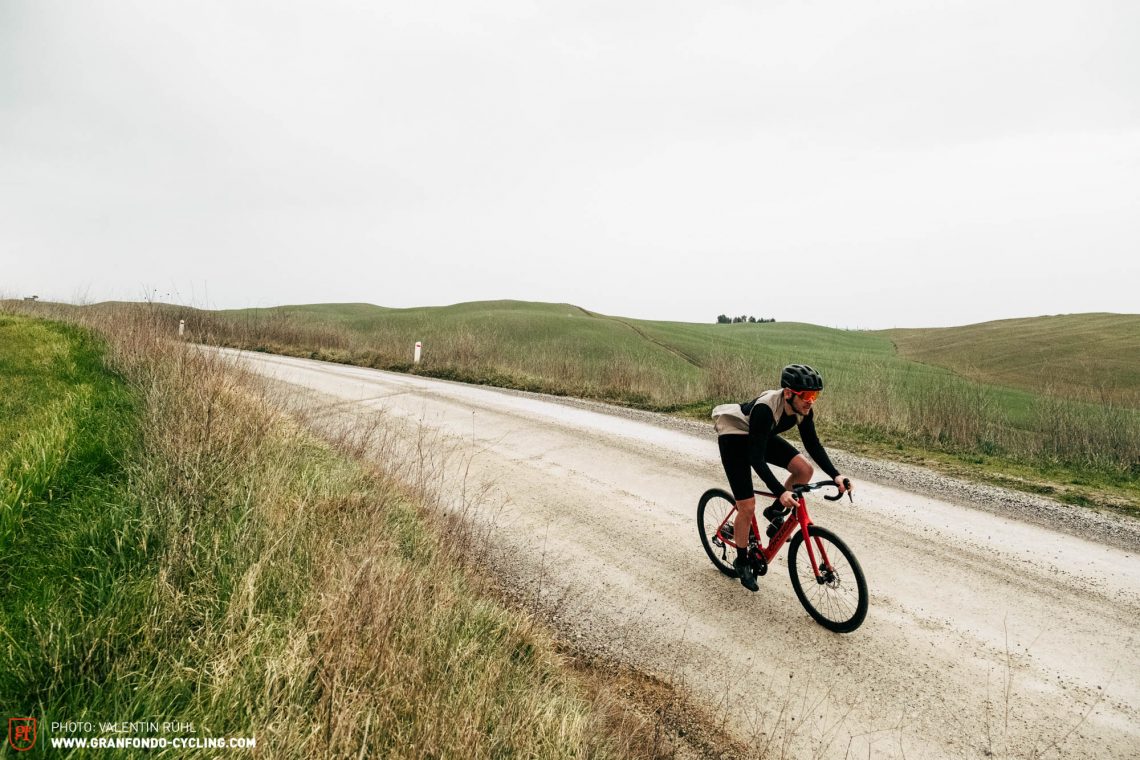
Riding Characteristics
4Agility
- cumbersome
- playful
Stability
- nervous
- confident
Handling
- demanding
- balanced
Fun factor
- boring
- lively
Comfort
- firm
- comfortable
Value for money
- terrible
- very good
Conclusion
The Orbea Gain M20i is a successfully conceived E-road bike for leisure riders and cruisers of all abilities who also want to be able to ride on gravel/hardpack and can go without the ultimate in precision handling. That positions it between the SCOTT Addict eRIDE Premium, which has more of a focus on asphalt, and the Trek Domane+ LT 9 which feels happy on long hardpack sections. However, sporty riders will miss efficiency above 25 km/h as well as more direct handling.
Tops
- high stability
- intuitive and good-natured handling
- light integration
- MyO customisation
Flops
- comfort imbalance between front and rear
- sometimes unnatural power output of motor due to its lack of a torque sensor

For more information head to orbea.com
The test field
For an overview of the test fleet head to the group test: The best road bike of 2021 – 15 models in review
All bikes in test: BMC Roadmachine 01 ONE (Click for review) | Cannondale SuperSix EVO Hi-MOD Disc Ultegra (Click for review) | Canyon Grail CF SLX 8 eTap (Click for review) | Cervélo Caledonia-5 Dura Ace Di2 Disc (Click for review) | Mason Resolution Ekar (Click for review) | MERIDA REACTO TEAM-E CUSTOM (Click for review) | MERIDA SCULTURA ENDURANCE CUSTOM (Click for review) | OPEN MIN.D. (Click for review) | Orbea Gain M20i | ROSE REVEAL FOUR DISC Ultegra Di2 (Click for review) | SCOTT Addict eRIDE Premium (Click for review) | Specialized S-Works Aethos (Click for review) | Storck Fascenario.3 Comp Disc Ultegra (Click for review) | Trek Domane+ LT 9 (Click for review) | Wilier Filante SLR (Click for review)
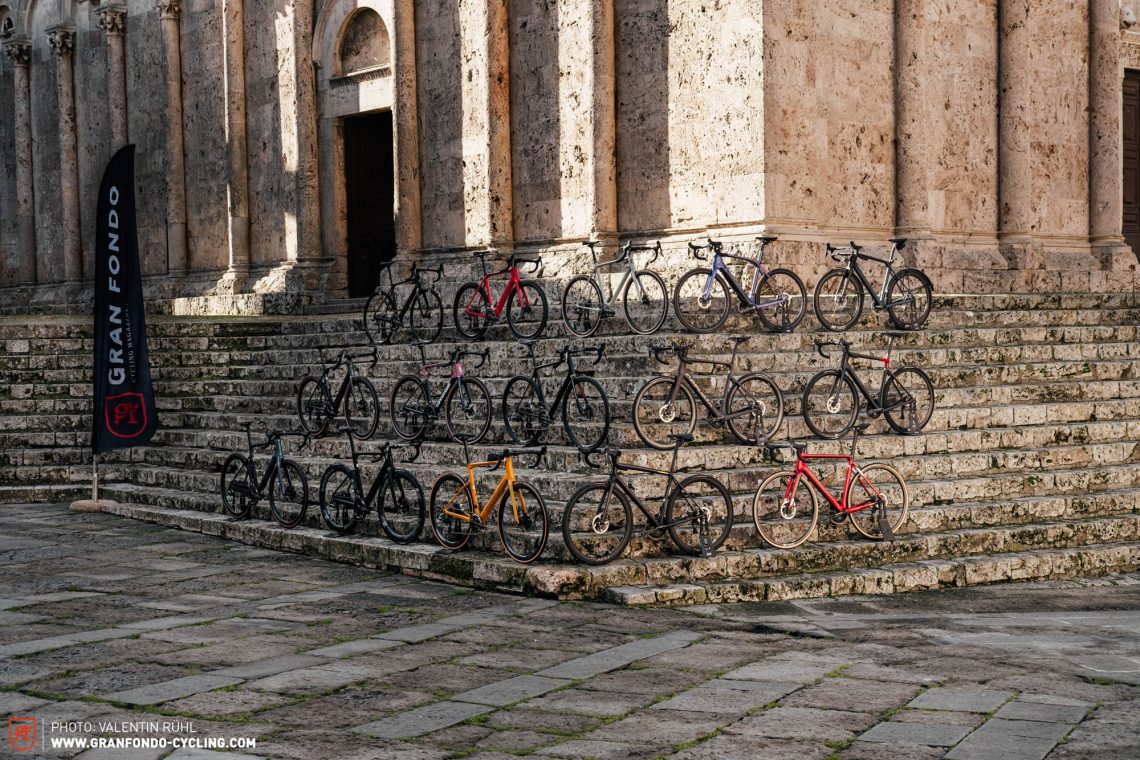
No, it’s not about perfect race tracks, it’s about efficiency. Fast, fleet-footed and efficient – those who want to speed along high-speed passages need a defined and spritely bike that accelerates with ease and efficiency. Nevertheless, reliable components are important too. We interpret “Smooth tarmac” bikes as follows: Hard efforts at high speeds with a maximum efficient bike on a consistently well-paved road. Effort-joy ratio: 80:30 (not everything has to be 100%!)↩
… also known as bike riding. Broken-up roads in the hinterland, deadlocked gravel roads, loose surfaces – sometimes muddy, sometimes bone-dry. For this, it takes bikes with super all-round, handling and wearing qualities uphill and downhill. Effort-joy ratio: 50:50↩
If you want to use your bike almost every day, you usually do not need an extremely tuned racing machine. Solid components, which are able to cope with the rigours of continuous usage in any kind of weather, are part of the basic equipment. At the same time, the bike should have practicable details: integrated fenders/assembly options, luggage racks/attachment points and a light system or at least the option of installing bike lights. The position on the bike should be rather relaxed, the overall comfort high, so that the Afterwork Ride becomes a cure and not a curse. Effort-joy ratio: 30:70↩
You can find more info about our rating system in this article: Click here! ↩
Did you enjoy this article? If so, we would be stoked if you decide to support us with a monthly contribution. By becoming a supporter of GRAN FONDO, you will help secure a sustainable future for high-quality cycling journalism. Click here to learn more.
Words: Photos: Valentin Rühl































